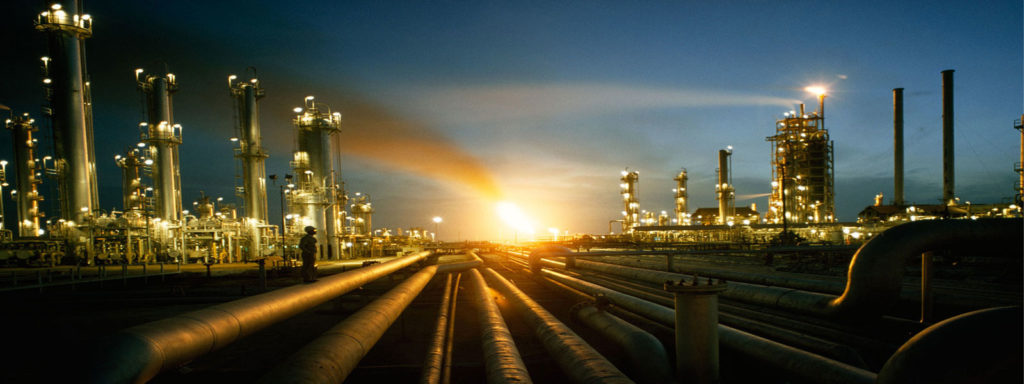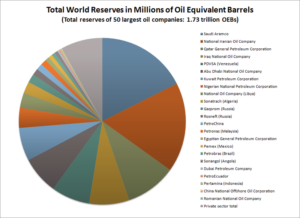
 Oil & Gas, any of a group of fuel gases produced from oil by exposing it to high temperatures. High-Btu oil gas is so called because of its high heating value; it is often used to supplement natural gas during periods of high demand. Refinery oil gases are produced as byproducts during normal heat treatment in oil refining. Their chief use is in the heating of refinery equipment. Typically, oil gas consists of methane, ethane, propane, butane, and some of their derivatives.
Oil & Gas, any of a group of fuel gases produced from oil by exposing it to high temperatures. High-Btu oil gas is so called because of its high heating value; it is often used to supplement natural gas during periods of high demand. Refinery oil gases are produced as byproducts during normal heat treatment in oil refining. Their chief use is in the heating of refinery equipment. Typically, oil gas consists of methane, ethane, propane, butane, and some of their derivatives.
The American Petroleum Institute divides the petroleum industry into five sectors:
- upstream (exploration, development and production of crude oil or natural gas)
- downstream (oil tankers, refiners, retailers and consumers)
- pipeline
- marine
- service and supply
Upstream
Oil companies used to be classified by sales as “supermajors” (BP, Chevron, ExxonMobil, ConocoPhillips, Shell, Eni and Total S.A.), “majors”, and “independents” or “jobbers”. In recent years however, National Oil Companies (NOC, as opposed to IOC, International Oil Companies) have come to control the rights over the largest oil reserves; by this measure the top ten companies all are NOC. The following table shows the ten largest national oil companies ranked by reserves and by production in 2012.
Petroleum in an unrefined state has been utilized by humans for over 5000 years. Oil in general has been used since early human history to keep fires ablaze and in warfare.
Its importance to the world economy evolved slowly, with whale oil used for lighting in the 19th century and wood and coal used for heating and cooking well into the 20th century. The Industrial Revolution generated an increasing need for energy which was met mainly by coal, and with other sources including whale oil. However, when it was discovered that kerosene could be extracted from crude oil and used as a lighting and heating fuel, petroleum was in great demand, and by the early twentieth century had become the most valuable commodity traded on world markets.
Petroleum is a naturally occurring liquid found in rock formations. It consists of a complex mixture of hydrocarbons of various molecular weights, plus other organic compounds. It is generally accepted that oil is formed mostly from the carbon rich remains of ancient plankton after exposure to heat and pressure in the Earth’s crust over hundreds of millions of years. Over time, the decayed residue was covered by layers of mud and silt, sinking further down into the Earth’s crust and preserved there between hot and pressured layers, gradually transforming into oil reservoirs.
The petroleum industry includes the global processes of exploration, extraction, refining, transporting (often by oil tankers and pipelines), and marketing petroleum products. The largest volume products of the industry are fuel oil and gasoline (petrol). Petroleum (oil) is also the raw material for many chemical products, including pharmaceuticals, solvents, fertilizers, pesticides, and plastics. The industry is usually divided into three major components: upstream, midstream and downstream. Midstream operations are usually included in the downstream category.
Petroleum is vital to many industries, and is of importance to the maintenance of industrial civilization in its current configuration, and thus is a critical concern for many nations. Oil accounts for a large percentage of the world’s energy consumption, ranging from a low of 32% for Europe and Asia, to a high of 53% for the Middle East.
Other geographic regions’ consumption patterns are as follows: South and Central America (44%), Africa (41%), and North America (40%). The world consumes 30 billion barrels (4.8 km³) of oil per year, with developed nations being the largest consumers. The United States consumed 25% of the oil produced in 2007. The production, distribution, refining, and retailing of petroleum taken as a whole represents the world’s largest industry in terms of dollar value.
Governments such as the United States government provide a heavy public subsidy to petroleum companies, with major tax breaks at virtually every stage of oil exploration and extraction, including the costs of oil field leases and drilling equipment.
| Top 10 largest world oil companies by reserves and production | ||||||||
| Rank | Company (Reserves) | Worldwide Liquids Reserves (109bbl) | Worldwide Natural Gas Reserves (1012 ft3) | Total Reserves in Oil Equivalent Barrels (109 bbl) | Company (Production) | Output (Millionsbbl/day)[1] | ||
| 1 | Saudi Aramco | 260 | 254 | 303 | Saudi Aramco | 12.5 | ||
| 2 | NIOC | 138 | 948 | 300 | NIOC | 6.4 | ||
| 3 | Qatar Petroleum | 15 | 905 | 170 | ExxonMobil | 5.3 | ||
| 4 | INOC | 116 | 120 | 134 | PetroChina | 4.4 | ||
| 5 | PDVSA | 99 | 171 | 129 | BP | 4.1 | ||
| 6 | ADNOC | 92 | 199 | 126 | Royal Dutch Shell | 3.9 | ||
| 7 | Pemex | 102 | 56 | 111 | Pemex | 3.6 | ||
| 8 | NNPC | 36 | 184 | 68 | Chevron | 3.5 | ||
| 9 | NOC | 41 | 50 | 50 | Kuwait Petroleum Corporation | 3.2 | ||
| 10 | Sonatrach | 12 | 159 | 39 | ADNOC | 2.9 | ||
The Petroleum industry is a favorite subject in contemporary fiction. Films with oil-industry themes include There Will Be Blood (2007) set around Southern California’s oil boom of the late 19th and early 20th centuries, and Syriana (2005) set in present-day Middle-East.
Some petroleum industry operations have been responsible for water pollution through by-products of refining and oil spills. The industry is the largest industrial source of emissions of volatile organic compounds (VOCs), a group of chemicals that contribute to the formation of ground-level ozone (smog).
The combustion of fossil fuels produces greenhouse gases and other air pollutants as by-products. Pollutants include nitrogen oxides, sulphur dioxide, volatile organic compounds and heavy metals.
As petroleum is a non-renewable natural resource the industry is faced with an inevitable eventual depletion of the world’s oil supply. The BP Statistical Review of World Energy 2007 listed the reserve/production ratio for proven resources worldwide. The study placed the ratio of proven reserves to production in the Middle East at 79.5 years, Latin America at 41.2 years and North America at 12 years. A simplistic interpretation of the ratio has led to many false predictions of immanent “running out of oil” since the early years of the oil industry in the 1800s. This has been especially true in the United States, where the ratio of proved reserves-to-production has been between 8 years and 17 years since 1920. Many have mistakenly interpreted the result as the number of years before the oil supply is exhausted. Such analyses do not take into account future reserves growth.
The Hubbert peak theory, which introduced the concept of peak oil, questions the sustainability of oil production. It suggests that after a peak in oil production rates, a period of oil depletion will ensue. Since virtually all economic sectors rely heavily on petroleum, peak oil could lead to a partial or complete failure of markets.
According to research by IBIS World, biofuels (primarily ethanol, but also biodiesel) will continue to supplement petroleum. However output levels are low, and these fuels will not displace local oil production. More than 90% of the ethanol used in the US is blended with gasoline to produce a 10% ethanol mix, lifting the oxygen content of the fuel.
Researchers have discovered that the petrochemical industry can produce ground-level ozone pollution at higher amounts in winter than in summer.
Midstream operations are sometimes classified within the downstream sector, but these operations compose a separate and discrete sector of the petroleum industry. Midstream operations and processes include the following:
Gathering: The gathering process employs narrow, low-pressure pipelines to connect oil- and gas-producing wells to larger, long-haul pipelines or processing facilities.
Processing/refining: Processing and refining operations turn crude oil and gas into marketable products. In the case of crude oil, these products include heating oil, gasoline for use in vehicles, jet fuel, and diesel oil. Oil refining processes include distillation, vacuum distillation, catalytic reforming, catalytic cracking, alkylation, isomerization and hydrotreating. Natural gas processing includes compression; glycol dehydration; amine treating; separating the product into pipeline-quality natural gas and a stream of mixed natural gas liquids; and fractionation, which separates the stream of mixed natural gas liquids into its components. The fractionation process yields ethane, propane, butane, isobutane, and natural gasoline.
Transportation: Oil and gas are transported to processing facilities, and from there to end users, by pipeline, tanker/barge, truck, and rail. Pipelines are the most economical transportation method and are most suited to movement across longer distances, for example, across continents. Tankers and barges are also employed for long-distance, often international transport. Rail and truck can also be used for longer distances but are most cost-effective for shorter routes.
Storage: Midstream service providers provide storage facilities at terminals throughout the oil and gas distribution systems. These facilities are most often located near refining and processing facilities and are connected to pipeline systems to facilitate shipment when product demand must be met. While petroleum products are held in storage tanks, natural gas tends to be stored in underground facilities, such as salt dome caverns and depleted reservoirs.
Technological applications: Midstream service providers apply technological solutions to improve efficiency during midstream processes. Technology can be used during compression of fuels to ease flow through pipelines; to better detect leaks in pipelines; and to automate communications for better pipeline and equipment monitoring.
Industry pioneers
Oil production
Financial and political |
Environmental issues Oil geology |
Oil-producing areas
Industry Research Projects Other articles |
